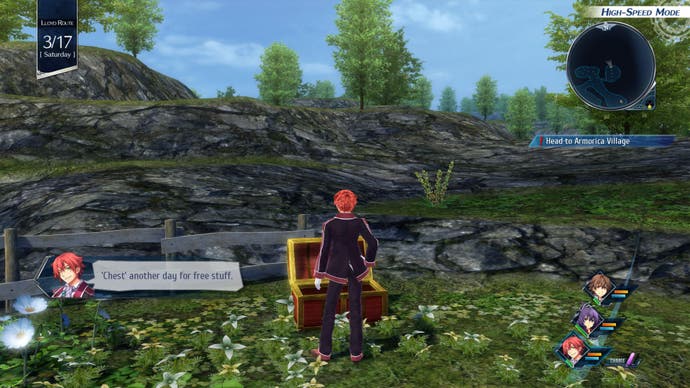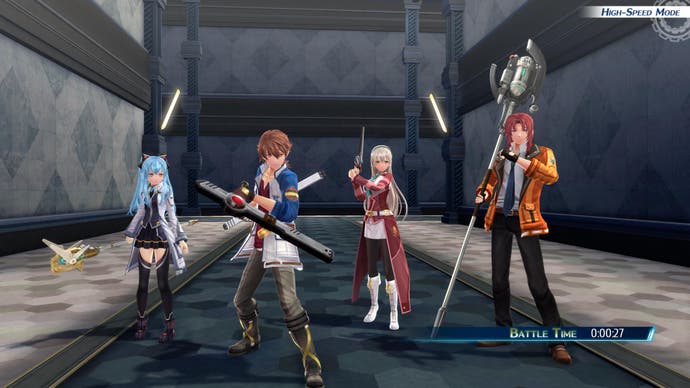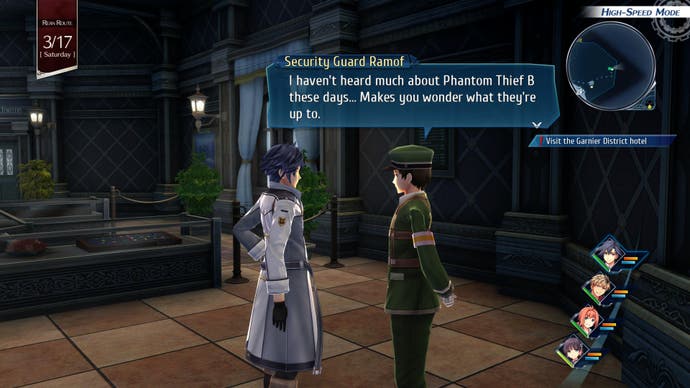The Legend of Heroes: Trails Into Reverie - a heartfelt conclusion that signals new beginnings
Once more onto the beach.
Returning to Crossbell and Erebonia left me surprisingly sentimental. Only three years have passed since my introduction to Nihon Falcom's RPG series, but Trails Into Reverie still feels pleasantly nostalgic, retreading familiar ground with a new high-stakes plot that provides critical reflection. After an incredibly long journey, Reverie calls time on Class VII and the Special Support Section's arcs while moving towards a new beginning.
Set five months after Cold Steel IV, a renewed struggle for Crossbell's independence kicks off this latest conflict with wide-reaching consequences. Split across three routes, you jump between the Crossbell police department's Special Support Section led by Lloyd Bannings, Class VII from Thors Military Academy, and the mysterious 'C.' Over-the-top action complements a compelling story even though Crossbell's plight feels overly drawn out. Still, some surprising twists redeem this.
Where Reverie shines is through its characters, and each route brings fresh perspectives to their actions. Rean, the man publicly revered as a war hero by Erebonia, finds his role scrutinised after being used as a nationalist icon. The SSS, long idealized as "heroes" by the Crossbell public, suddenly face the reality that such expectations have placed upon them. C's route is hard to discuss without spoilers, but I enjoyed this redemptive tale. Two wars and imperial occupation have left some deep scars, leading to an intriguing re-examination of prior events.



I also enjoyed how Reverie ties up some remaining loose ends from Crossbell and Cold Steel, which feels particularly rewarding for those who've been on this entire journey. Seeing how far the old Class VII has come since those awkward student days was lovely and moments the Ironbloods grapple with Chancellor Osborne's legacy provide most character arcs some welcome closure. Visiting Cold Steel's older locations, like Heimdallr and Nord, added comforting familiarity and I often found myself smiling.
Many of these character moments occur within the True Reverie Corridor (TRC), a new location where each route merges. Side quests don't exist in Reverie beyond basic events like defeating powerful monsters, but there's still plenty to do. The TRC is where most of this takes place, it feels like a cross between Cold Steel III's Einhel Keep and Sky The 3rd's Phantasma. You could go fishing, participate in combat trials, play minigames like the Puyo Puyo-inspired Pom! Pom! Party! and train across randomly generated dungeons, there's good variety to keep you coming back.
These TRC dungeons are crucial to unlocking additional functions, so we're clearing out monsters once more. Reverie plays almost exactly like Cold Steel so combat remains familiar, sticking to turn-based battles using grid-based movement. Every ally has regular attacks alongside magical 'Arts' for elemental damage and support abilities, costing time and EP. Finally, crafts provide unique skills that cost CP, built up during combat. Reaching 100 CP provides an "ultimate attack" called S-Crafts, doubling the damage at 200CP. The fundamentals remains unchanged and that's fine.



As someone who's played Zero/Azure more recently than Cold Steel, Reverie adds substantial strategic depth to its older predecessors. Combat links pair two allies for increased combat support. Unbalancing an enemy mid-fight lets the linked partner perform a follow-up attack, with the most potent option bringing the whole party into an all-out assault. Then there are Brave Orders, which don't use a turn and can temporarily boost stats like crit damage or defense. Both features complement Reverie's expansive combat customisation
Battles build upon the combat links system further with one significant change, United Front. Using your party's backup units too instead of just active combatants, a full charge on the Assault Gauge lets you choose "Valiant Attack," "Valiant Heal," or "Valiant Arts," and its strength is proportionate to your party size. It's a powerful mechanic that can favourably swing battles if used effectively, and I found it particularly helpful during some challenging boss fights.
I do wish I wasn't juggling over 50 playable characters, though. As the corridor lets you manage everyone's equipment at once, this becomes rather tedious. It's crucial to stay prepared as Reverie incentivises mixing up your party with 'Missions,' cleared by hitting set criteria like completing dungeon floors or killing foes with two combat linked characters. Finishing missions awards shards that purchase important upgrades, such as increased improved United Fronts. Like Crossbell's Detective Points and Cold Steel's Academic Points, Reverie Points rewards thorough progress across the main story and Missions with valuable new items.

It's a busy life within the corridor and alongside the main story progression, many of the TRC's extra features rely on exploring these dungeons to find Orbs. These unlock the different minigames, additional characters, new items and, perhaps most crucially, 'Daydreams.' Reminiscent of Sky The 3rd's Memory Doors, Daydreams is a series of side stories that spotlight supporting characters who usually wouldn't be the main focus, often filling in blanks during the five-month gap.
Not everyone get a side story, yet I'm content with this structure. The wider cast gets their moment without creating the same pacing issues Cold Steel IV suffered from. Falcom giving every present character at least one line left that story often feeling unnecessarily protracted. Reverie isn't entirely innocent of this but it's not a significant issue and each team's natural rapport remains just as endearing. Trails' entertaining humour reinforces that. Whether it's the casual teasing of Rean's obliviousness or more comedic daydreams, Reverie balances its events with a lighter touch.
That's partially why I miss the Cold Steel bonding events, which let you build relationships with other allies during Rean's free days. However, this isn't a criticism as Reverie's structure doesn't suit those social mechanics. Those segments simply offered a great avenue for character development. On a related note, you can link your save data from IV to register who you spent the final bonding scene with, and that makes very minor dialogue changes.


I've previously called world-building the series' biggest strength and reaching the end of Reverie reminded me why. Witnessing the foundations for each nation's future slowly forming shows how far this series has come and you can see why Falcom considers this the end of Trails' first half. I'd call it a long goodbye, were I not aware of some returning faces in the next arc. Several moments provide clear foreshadowing for what's coming next in Calvard, usually within the Daydreams, and I'm certainly intrigued.
Given Falcom's penchant for returning characters, I don't believe for a second that Rean's return isn't being planned but I'm relieved both arcs ended with such a strong conclusion. Thanks to the strong character writing, refined combat and improved pacing, revisiting these locations one last time was lovely. I couldn't have hoped for a much better epilogue and I'll patiently await Kuro No Kiseki's inevitable appearance next.
.jpg?width=690&quality=75&format=jpg&auto=webp)
